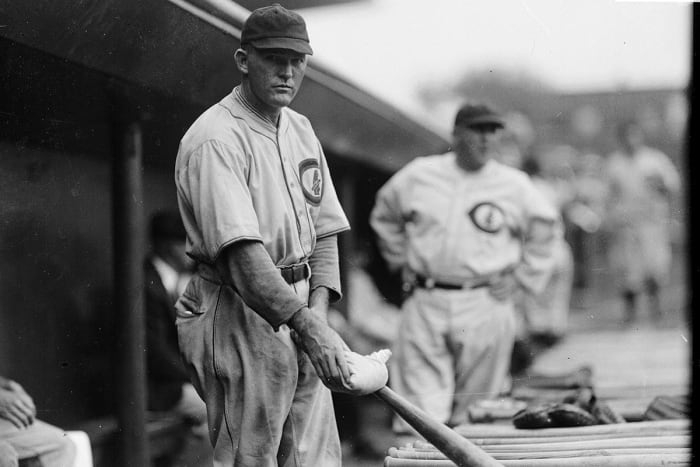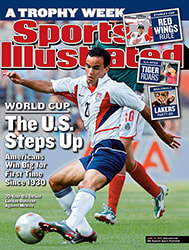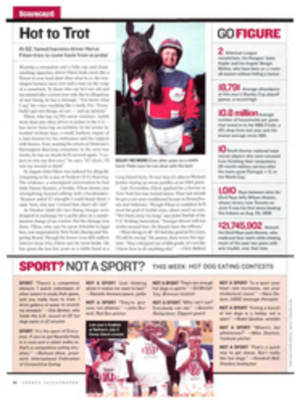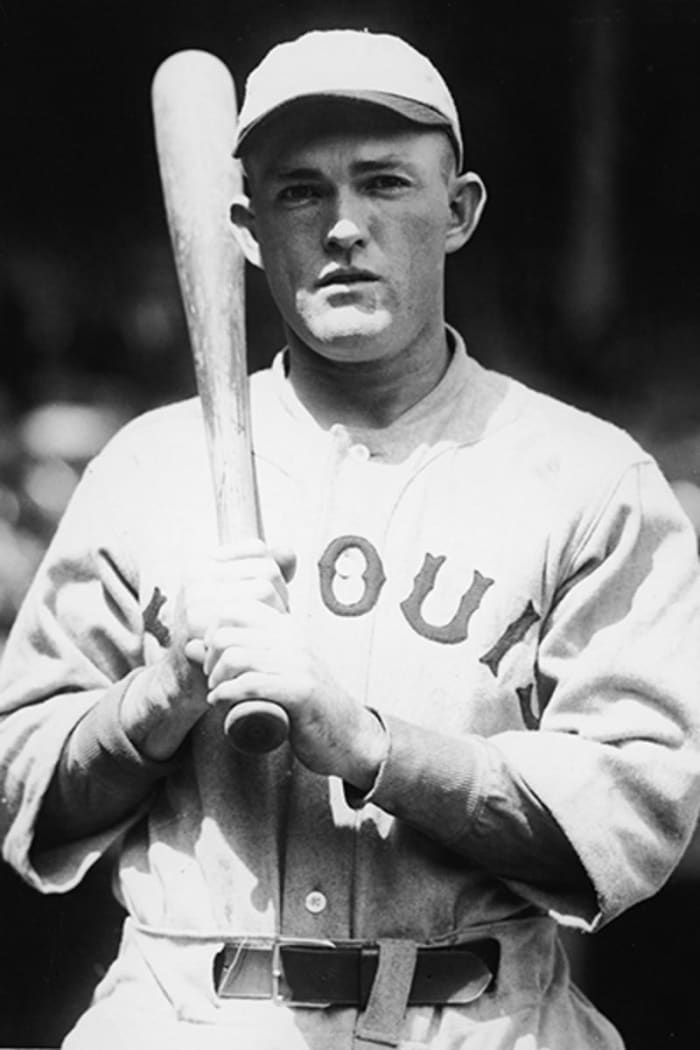Hail To The Rajah
Ted Williams will go down in baseball history as the greatest theorist of hitting. Asking Theodore Rex about batting was like asking Albert Einstein about quantum physics. Williams called his landmark instructional book The Science of Hitting. (You want art, go to a museum.) Just as Einstein was able to reduce his theory of relativity to a single equation, Williams, the best hitter of all time, was able to distill his theory of hitting to a single sentence: Get a good pitch to hit.
He borrowed it from another guy.
Before there was Williams, there was Rogers Hornsby, the best righthanded hitter of all time. Before Teddy Ballgame arrived on the scene in 1939, Hornsby was arguably the best all-around hitter baseball had seen. He hit for power and average, season after season, for more than 20 years, beginning in 1915. On those rare occasions when he struck out, his annoyance was deep.
Many of the good hitters in the game today--men like Mike Piazza and Nomar Garciaparra and Shawn Green, who hit for average and power--pay homage to Williams. They've studied him. In the discipline they bring to every at bat, they are daily reminders of Williams. Piazza's confidence is rooted in praise that Williams paid him when Piazza was still in high school. Garciaparra has sat at Williams's elbow for long off-season chats, two hitters talking shop. When Green was at the 1999 All-Star Game at Fenway Park, he carefully positioned himself in the runway so he could meet his hitting hero.
But who today pays his respects to Hornsby, the Splinter's hitting forebear, the Newton to his Einstein? Who talks about the father of the father of modern hitting? Only old-timers.
Bob Feller's first two years as a big league pitcher, 1936 and '37, were Hornsby's final two as a player. Feller faced Hornsby and later pitched against a club managed by him. "In '37 Hornsby was 41 years old and still the best hitter on the St. Louis Browns," says Feller. An 83-year-old Hall of Famer now, Feller was a teenager off an Iowa farm when he pitched to Hornsby. His memory is astonishing: "He used a bat with a big barrel, like Ruth's, a medium-sized handle and no knob. He was very difficult to strike out. He had his theories about hitting. He didn't try to pull the ball; he hit everything right through the box. He wasn't the talker Ted was, but then again a lot of what Ted said was horsefeathers. Hornsby didn't need a lot of words."
The Rajah played 23 seasons, beginning with the St. Louis Cardinals and going on to the New York Giants, Boston Braves, Chicago Cubs and the Browns. As a second baseman, he was skillful at turning double plays but weak chasing pops in shallow center and right. He stole few bases. At the plate he had no limitations. In his hitting swan song, as the Browns' player-manager in 1937, Hornsby sent himself to the plate only 56 times, chiefly to bat for somebody less able. He hit .321. For his career he averaged .358--the second best of all time, behind the much less powerful Ty Cobb--cranked out 301 home runs and struck out only 679 times in 8,173 at bats. (Sammy Sosa, for example, had whiffed 663 times in only 2,449 at bats from 1998 through 2001.)
In 1922 Hornsby batted .401, hit 42 homers and struck out a mere 50 times. He practically duplicated that season in '25, with a .403 average, 39 home runs and 39 strikeouts. He won the batting title seven times in the Roaring '20s, reaching his highest average (and the highest of anyone after 1900), .424, in '24. Williams was a much more productive home run hitter than Hornsby--Williams homered once in every 15 at bats, Hornsby once in 27--but in almost every other regard Hornsby was Williams's equal or better.
In 1938, during the first spring after his final season as a player, Hornsby, a prickly man and a compulsive gambler, took the only job he was offered, as spring training batting coach for the Minneapolis Millers, a Double A team that trained in Daytona Beach. Williams was a 19-year-old boy wonder on that team. From that March on, Williams has been generous in his praise of Hornsby. "I've always felt Rogers Hornsby was the greatest hitter for average and power in the history of baseball," Williams wrote in his book My Turn at Bat. "I liked Hornsby because he talked to me, a kid of nineteen, and boy I picked his brains for everything I could."
Williams batted .366 with 43 home runs for Minneapolis. The next season he was with the Boston Red Sox, and he said, "Something Rogers Hornsby had told me in Florida the year before was fast becoming a cardinal rule for me: Get a good ball to hit."
Williams clings to that phrase still. "You hear it from him all the time," says John Kriston, the executive director of the Ted Williams Museum in Hernando, Fla. "He'll say, 'That's what I learned from Rogers Hornsby when I was 19.'"
Al Lopez, a Hall of Fame catcher, was behind the plate for dozens of Hornsby's at bats in the early 1930s, when Lopez played for the Brooklyn Dodgers and Hornsby for the Cubs. Lopez saw the pitches Hornsby let pass. He never saw a better batting eye. "His eye was so good, he never had any trouble with the umpires," says Lopez, who is in good health at 93. "When Hornsby took a pitch, the umpires assumed it was a ball. When they did call strikes on him, he never squawked. All he wanted to do was hit the ball hard. After Hornsby's rookie year, Honus Wagner told him to stand as deep in the box as he could. Pitchers thought they could get Hornsby on the outside part of the plate, but he just stepped into that pitch and drove it to right center. For him, no pitch was inside, no pitch was outside. He could hit any strike. He was my hitting idol."
In his first season Hornsby went 14 for 57, a .246 average. The next year, with the new stance suggested by Wagner, he batted .313, and he was off.
In 1952 and '53 catcher Andy Seminick played for Hornsby, who was then managing the Cincinnati Reds. Seminick, now 81, well remembers those seasons. Hornsby would watch his players take batting practice, become disgusted with what he saw, step up to the plate and rip one line drive after another. Do as I do. Hornsby was then in his mid-50s.
"He had a great swing even then, such good control of the bat," says Seminick, who still does some coaching in the Florida Instructional League. "He had all sorts of notions. He didn't like us to stay at hotels with air conditioning. He said air conditioning freezes up the body. He didn't want us to go swimming because he claimed swimming used the wrong muscles for baseball and was bad for you. He didn't want us to play golf, either. He said we needed to conserve our energy. He was opposed to reading and going to the movies. He said they hurt your batting eye. Most of us, we didn't do what he said--we just didn't believe him--but we were all in awe of his stroke."
The Reds finished sixth in the National League in 1953, and Hornsby's managing career was over. As for Seminick, he read the paper every morning. Went to the movies, too. He was a good defensive catcher--but a career .243 hitter.
In 1962 Hornsby was the hitting coach for Casey Stengel's hapless expansion New York Mets. Hornsby tried to teach his charges how to swing (weight off the front foot) and how to bunt (bat ahead of the plate), but they won only 40 games. Ted Williams's playing career had concluded, with a home run, not two years earlier, and by the '62 season he had begun his rich postplaying life, as a hunter and fisherman. Hornsby was sticking to the only life he knew, that of a baseball man. He continued to eat eggs for breakfast, steak for dinner, ice cream for dessert, just as he had as a player, believing those protein-rich foods kept his body strong. What those foods were doing to his arteries he did not know. He died on Jan. 5, 1963, of heart failure. He was 66.
Forty years after Hornsby's final season he is largely a forgotten man. Garciaparra says of Williams, "Ted's the greatest hitter of all time and is my friend. I can call him on the phone anytime I want. That's the greatest."
Of Hornsby, Garciaparra says, "I don't know anything about him, to tell you the truth." The thing is, if you're a true Williams disciple, you are, by extension, a disciple of the Rajah. You just may not know it.



